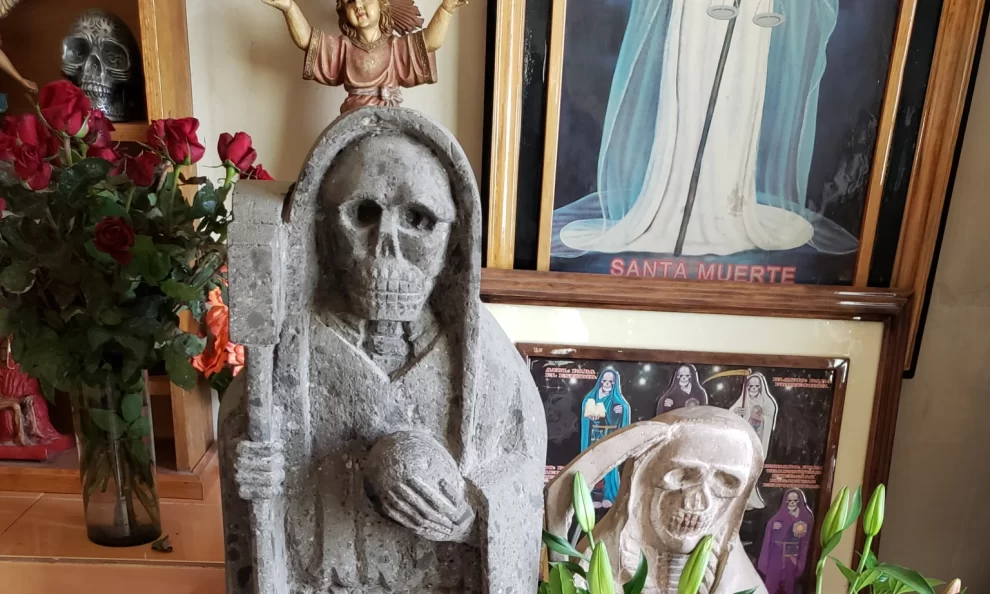Marisela, a young Mexican-American woman, was going through a period of debilitating anxiety and depression. “I was in such a bad state,” she said. “I kept on binge eating. My thoughts were of the darkest kind. My self-esteem was so low I stopped taking showers, sometimes for a month at a time.”
A survivor of abuse, Marisela felt guilty and hopeless, as though there was no point even in pursuing basic hygiene. And, she felt, no one understood what she was experiencing.
“I began talking to a bruja (witch) and she told me to look up Santa Muerte,” said Marisela. “So I did. I read just one sentence about la Madrina and I felt a huge, warming, peaceful, joyfulness within my soul so pure that I wanted to burst into happy tears. I knew this was my calling. I started to slowly pray to her and turn to her and with each day my faith grew stronger.”
Santa Muerte is a Mexican folk saint who personifies death: her name translates both as “Holy Death” and “Saint Death.” Devotion to Santa Muerte is the fastest-growing new religious movement in the Americas. Whether portrayed on a votive candle, a gold medallion, or a prayer card or as a plaster statue, she is most often depicted as a female Grim Reaper, wielding the same scythe and wearing a shroud similar to her male counterpart. Some of her common sobriquets include the Bony Lady, the Powerful Lady, the Skinny Girl, the White Girl, the Bone Mother, and the Lady of the Shadows.
Unlike official saints who have been canonized by the Catholic Church, folk saints are spirits (sometimes spirits of the dead) who are considered holy because of their miracle-working powers. In Mexico and Latin America in general, such folk saints as Niño Fidencio, Jesus Malverde, Maximon, and San la Muerte (the male Argentine counterpart of Santa Muerte) command widespread devotion and are often implored more than the official saints. These popular saints are united to their devotees by nationality and often by both locality and social class.
While the Bony Lady is condemned as heretical by both the Catholic and Protestant churches in Mexico, she has gained a massive following among marginalized groups, such as the urban poor, LGBTQ communities, and those involved in illicit activities in Mexico, Central America, and the United States. The folk saint of death is important to these groups because she provides a sense of empowerment, identity, solace, and protection amid social and economic tribulations.
One primary reason why Santa Muerte is popular among less advantaged groups is her extreme inclusiveness; she is the saint who never discriminates. Christian denominations have often marginalized certain groups due to sexual orientation, socioeconomic status, or involvement in illegal activities. Santa Muerte, in contrast, offers a spiritual path that does not discriminate. Anyone, regardless of their background or lifestyle, can turn to the skeleton saint for protection, solace, and guidance.
Santa Muerte’s appeal also lies in her capacity to empower individuals whose lives are otherwise marred by hardship and adversity. Holy Death is often considered a patroness of the downtrodden; those facing economic struggles and societal discrimination turn to her as a source of strength and motivation. For many of her worshippers, devotion to Santa Muerte is not only a religious expression but also a means of asserting agency. Demographic groups that have little influence in sociopolitical systems gain a sense of control through their devotion to the Powerful Lady. By appealing to her, they believe they can improve their lives, protect themselves and their loved ones, and assert themselves in societies that often suppress their voices.
For those who find themselves in hostile environments, both economically and socially, Santa Muerte is seen as a protector, offering her devotees a sense of security in Mexico, Central America, and the United States, all countries plagued by violence and poverty. Wielding her oversized scythe as a shield, she is a guardian of the weak, serving as a source of comfort and reassurance in the face of adversity. People involved in criminal activities such as drug cartels or gangs often face danger and violence, even the risk of murder; narcos, for instance, may beseech Santa Muerte for protection from harm and retribution. Her ritual paraphernalia is often found in the safehouses of these groups, symbolizing a supernatural guardian who watches over them. In Central America and Mexico, where the legal system fails to protect disenfranchised individuals involved in such activities, Santa Muerte offers a sense of security.
Santa Muerte can serve as a symbol of hope and salvation, especially for those who have led a life of crime or addiction, who often see the skeleton saint as a path to spiritual transformation and an opportunity to escape their troubled pasts. She offers a means to seek forgiveness, make amends, and find a new purpose in life. For those serving prison sentences, Santa Muerte represents the possibility of redemption and transformation. In Mexican and U.S. prisons, inmates commonly erect small altars to her in their cells. In fact, Santa Muerte is so popular among both inmates and prison guards in Mexico that she can be considered the patron saint of the entire Mexican penal system. Both inmates and guards ask the death saint to protect them from the constant dangers of prison life, while the former also pray to her for a speedy release.
Santa Muerte stands out as a powerful female spiritual figure in largely patriarchal societies. For deprivileged women, she symbolizes a female empowerment that transcends traditional gender roles and expectations. In societies where gender discrimination and violence against women are prevalent, Santa Muerte is an image of female strength and independence. This is especially the case in Mexico, where an ongoing femicide epidemic has led to an average of ten women murdered every day, mostly by husbands and boyfriends. Last year, police in Mexico City raided the safehouse of a radical feminist group that had an impressively elaborate shrine to the Powerful Lady filled with law-enforcement gear, such as helmets and batons. Group members view the death saint as a powerful protectress and ally in their struggle to smash toxic patriarchy.
Many LGBTQ communities embrace Santa Muerte as an icon of acceptance and empowerment for non-binary and transgender individuals. Her image allows them to celebrate their identities and find strength in their unique experiences, which are often disregarded by more traditional Christian denominations. The most prominent Santa Muerte devotional leader in the United States, Arely Vazquez, is a transgender woman who, after experiencing discrimination in the Catholic Church in her home state of Guerrero, Mexico, found radical acceptance in embracing Santa Muerte. Many of her fellow devotees in the New York borough of Queens are also transgender.
In communities where violence and death are common, Santa Muerte aids people who are experiencing loss. She serves as a comforting maternal figure, helping individuals cope with the sorrow associated with death, especially when it’s sudden and violent. Families of victims of violence, particularly in areas plagued by narco-violence, often turn to the Powerful Lady as a source of strength and resilience. Devotion to her helps them memorialize their lost loved ones and seek justice in systems that often fail to provide it.
In the popular cultures of Mexico and Central America, Santa Muerte’s image has found its way into various forms of media, music, art, and literature, allowing marginalized groups to express themselves and connect with her on a broader scale. She has become a symbol of defiance and resistance for people excluded from mainstream societal narratives. In popular culture, the saint of death is celebrated as a symbol of nonconformity and rebellion. Her imagery is widely recognized, making her a source of pride and identity for those who feel excluded by society.
As marginalized groups continue to face social and economic hardships, Santa Muerte has emerged as a vital symbol of support, identity, and empowerment for those who have often been excluded from mainstream society. Christians who may be inclined to condemn devotion to Santa Muerte, as well as other alternative religious movements, as “heretical” and “abominable” might do well to examine the ways in which their own denominations and churches have contributed to the marginalization of their sisters and brothers. The radical inclusiveness of the Bone Mother of the marginalized may hold some valuable lessons for Christian groups that are losing many of their flock.
Image: Andrew Chesnut














Add comment